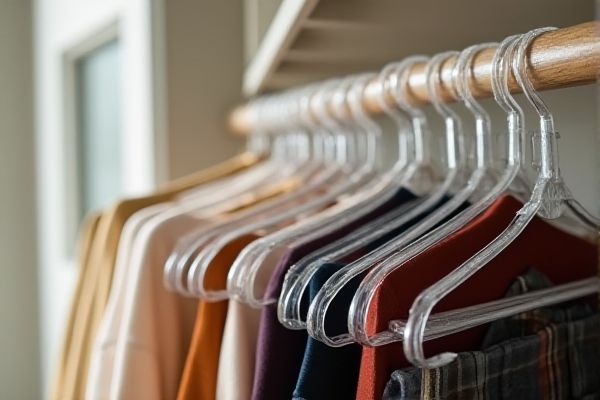
Velvet hangers provide a non-slip surface that keeps your clothes secure and prevents creasing, while plastic hangers are lightweight and cost-effective but may cause garments to slip or develop shoulder bumps. Discover which hanger type best suits your wardrobe organization needs by exploring the rest of this article.
Table of Comparison
| Feature | Velvet Hangers | Plastic Hangers |
|---|---|---|
| Material | Velvet-covered metal or plastic frame | Durable plastic |
| Clothing Grip | Non-slip velvet surface prevents clothes from slipping | Smooth surface, prone to slipping |
| Durability | Moderate; velvet can wear over time | High; resistant to breakage |
| Weight Capacity | Suitable for lightweight to medium garments | Supports heavier garments |
| Aesthetic | Elegant, slim, and space-saving design | Varies; bulkier and less refined |
| Price | Higher cost due to materials and design | Budget-friendly and widely available |
| Environmental Impact | Varies; reuse possible, but velvet layer non-biodegradable | Typically less eco-friendly; plastic waste concerns |
Introduction: Velvet Hangers vs Plastic Hangers
Velvet hangers provide a non-slip surface that prevents clothes from slipping off and wrinkling, making them ideal for delicate fabrics and maintaining garment shape. Plastic hangers are lightweight, affordable, and widely available but often lack the grip and durability needed to support heavier clothing items without bending or breaking. Choosing velvet hangers can enhance your closet organization and garment care by reducing damage and extending the life of your wardrobe.
Material Overview: Velvet vs Plastic
Velvet hangers are typically crafted from a thick metal or plastic core covered with soft, non-slip velvet fabric, providing gentle support for delicate clothing and preventing slips. Plastic hangers are molded from various types of plastic such as polypropylene or polystyrene, offering durability and lightweight strength but lacking the friction needed to securely hold slippery fabrics. The velvet coating on hangers enhances grip and protects garment shapes, while plastic hangers prioritize cost-effectiveness and ease of mass production.
Durability and Longevity Comparison
Velvet hangers offer moderate durability, with their soft fabric coating prone to wear over time, especially under heavy garments, while plastic hangers typically provide greater longevity due to their rigid, impact-resistant construction. High-quality plastic hangers resist cracking and bending, making them suitable for long-term use in varied humidity conditions compared to velvet hangers that may degrade or lose grip when exposed to moisture. The choice between velvet and plastic hangers hinges on balancing the need for gentle fabric protection with the demand for structural resilience and extended lifespan.
Space-Saving Capabilities
Velvet hangers offer superior space-saving capabilities compared to plastic hangers due to their slim profile, allowing you to fit more clothes in your closet without overcrowding. Their non-slip surface keeps garments securely in place, reducing the need for extra space between hangers to prevent slipping. Choosing velvet hangers maximizes your closet's storage efficiency while maintaining garment organization.
Grip and Slip Resistance
Velvet hangers offer superior grip and slip resistance compared to plastic hangers, thanks to their textured fabric surface that prevents clothes from sliding off. This enhanced grip helps maintain the shape and position of delicate garments, reducing the risk of wrinkles and damage. Your wardrobe will benefit from increased organization and garment care when you choose velvet hangers over plastic ones.
Impact on Clothing Shape
Velvet hangers provide superior support and prevent clothes from slipping, maintaining the original shape of garments by reducing stretching and creasing. Plastic hangers often lack adequate structure, causing shoulders to warp and fabric to stretch, which can distort clothing over time. Choosing velvet hangers enhances garment longevity by preserving fabric integrity and shape consistency.
Aesthetic Appeal and Style
Velvet hangers elevate your closet's aesthetic appeal with their sleek, non-slip surface and vibrant colors, creating a luxurious and cohesive look. Plastic hangers often lack the refined texture and contouring that velvet hangers provide, making them appear less stylish and often bulkier. Choosing velvet hangers enhances the overall style of your wardrobe, giving it a polished and organized appearance.
Cost and Value Analysis
Velvet hangers typically cost between $1.50 and $3.00 each, offering superior grip and preventing clothes from slipping or stretching, which extends the lifespan of your garments. Plastic hangers are generally cheaper, ranging from $0.20 to $1.00 per hanger, but they often lack durability and can lead to misshapen clothing over time, reducing overall wardrobe longevity. Considering both cost and value, velvet hangers provide a better long-term investment for preserving your clothing while plastic hangers serve as a budget-friendly, short-term solution.
Eco-Friendliness and Sustainability
Velvet hangers offer greater eco-friendliness compared to plastic hangers, as they are often made with sustainable materials and have a longer lifespan, reducing landfill waste. Plastic hangers contribute significantly to environmental pollution due to their non-biodegradable nature and difficulty in recycling. Choosing velvet hangers supports your commitment to sustainability by minimizing plastic use and promoting an eco-conscious wardrobe organization.
Best Uses and Buyer Recommendations
Velvet hangers are best suited for delicate fabrics like silk, chiffon, and knitwear, as their non-slip surface prevents garments from slipping and creasing, making them ideal for organizing sweaters, dresses, and blouses. Plastic hangers are more durable and affordable, typically recommended for heavier items such as coats, jackets, and casual wear, offering sturdy support and easy maintenance. Buyers seeking to preserve fine clothing and maximize closet space should opt for velvet hangers, while those prioritizing cost-effectiveness and robustness may prefer plastic hangers for everyday wardrobe essentials.
 homyna.com
homyna.com